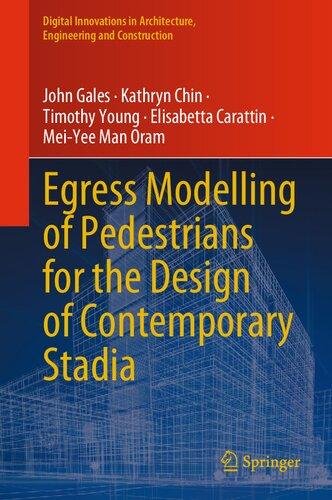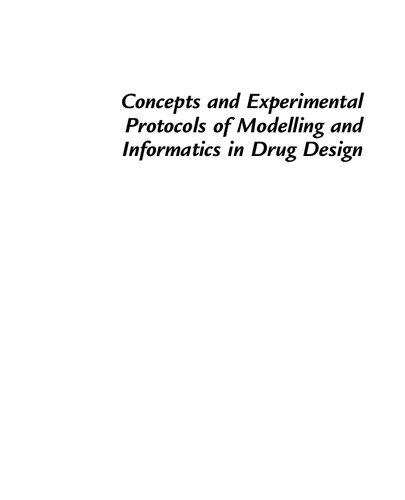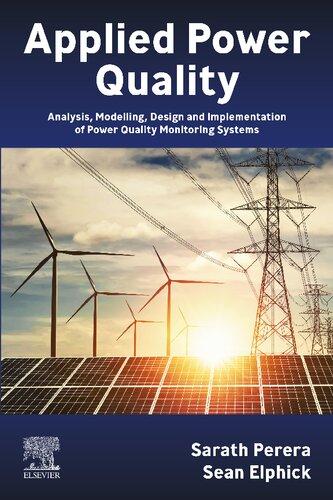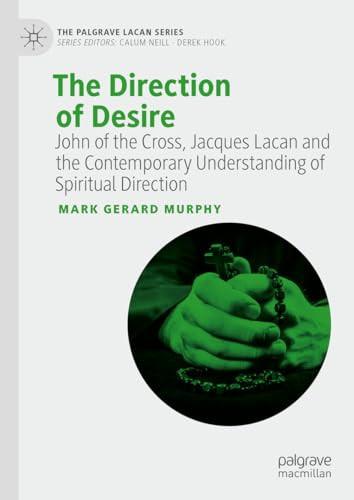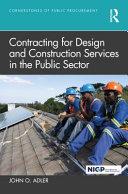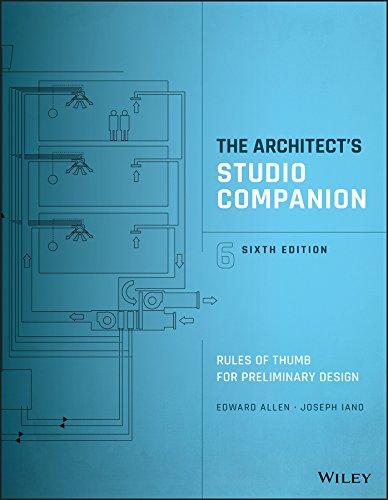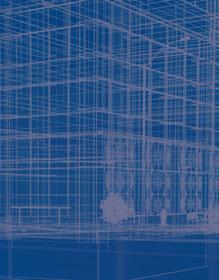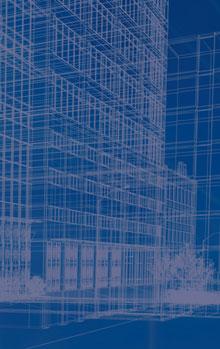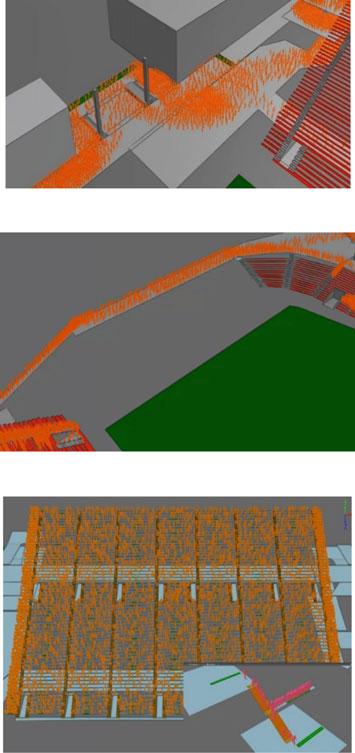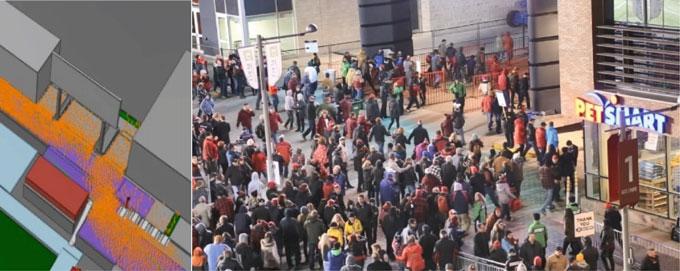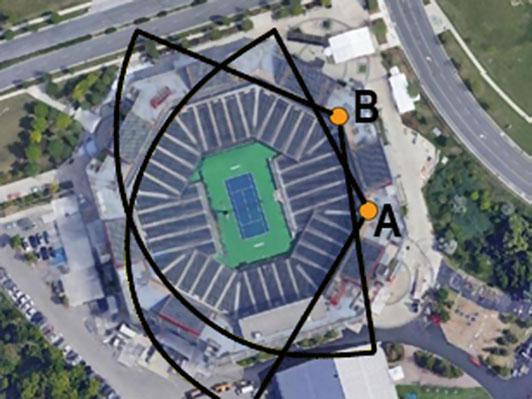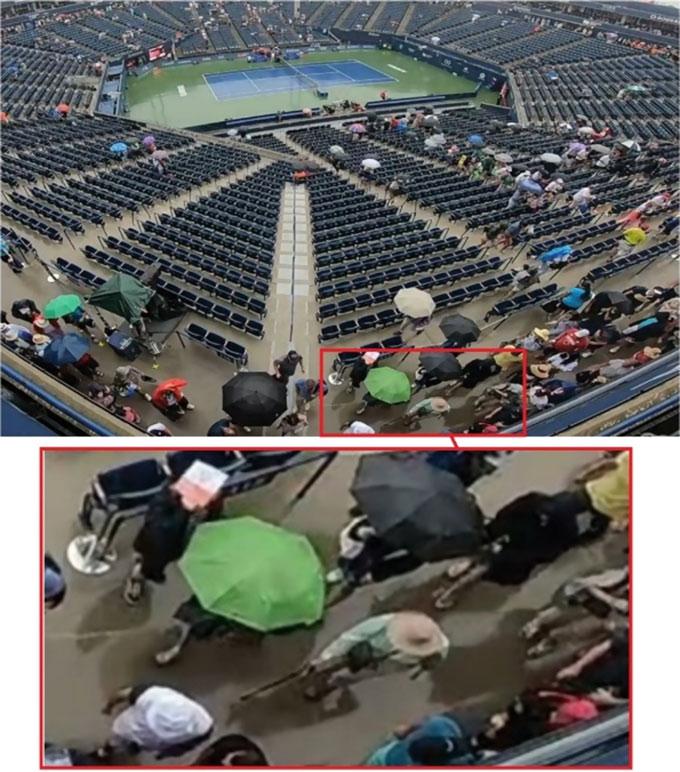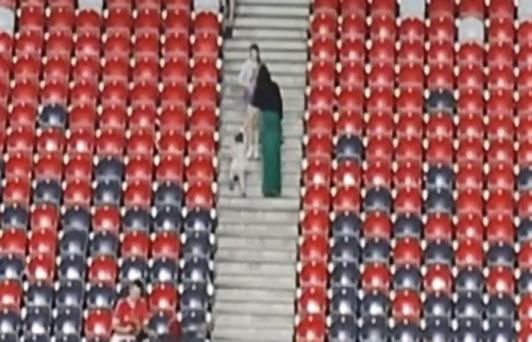Chapter 1 Introduction to Pedestrian Movement and Behaviour in Stadia

Abstract There is a significant population of mobility related disabled persons in Canada. Recent studies have shown accessibility and mobility are a large concern in stadia egress which requires more research and practitioner attention. In 2019, Canada enacted the Accessible Canada Act to address this issue by focusing on identifying, removing, and preventing barriers that limit social, political and economic inclusion. However, the act currently requires only minimal design considerations which would be helpful to a select group of disabled persons, and for only certain types of buildings, often excluding stadia. Accessibility should offer equal quality of life for all disabled persons as well as non-disabled persons. There is a lack of research on understanding the behaviour of disabled persons in egress of stadia which designers require. Therefore, a Canadian tennis stadium will be analyzed during normal circulation and egress situations. The chapter presents a literary background for movement of disabled persons in egress and presents reviews of both Canadian and international design guidance for egress identifying areas of focus for later chapters. While the chapter focuses on the Canadian context, general conclusions may be globally applicable.
1.1 Introduction and Motivation
In addition to guidance documents, such as the Green Guide, the advancement of stadia design in the last few decades has considered the emergence of novel tools and technologies that have been created by industry.1 Largely these tools are based upon accurate representation of human movement and behaviour. These tools are based upon the advancements of Artificial Intelligence (AI). Tools and technologies largely exist in the form of advanced modelling tools which aim to represent the population within the stadium. These technologies are very useful for representing crowds found within stadia and enable a designer to quickly identify areas of crowd congestion to enable new designs for improved movement in that space. Figure 1.1
1 The majority of pedestrian movement software that has been developed primarily has been done in industry settings with support from academic institutions.
© The Author(s), under exclusive license to Springer Nature Switzerland AG 2023 J. Gales et al., Egress Modelling of Pedestrians for the Design of Contemporary Stadia, Digital Innovations in Architecture, Engineering and Construction, https://doi.org/10.1007/978-3-031-33472-6_1
illustrates the use of a pedestrian movement model to represent crossflow, bottlenecks and consequences of decision making.
Contemporary stadia design requires an in-depth consideration of real human behaviour. The reliability of pedestrian movement models used for exit and evacuation design will depend on the confidence of the input movement and behavioral data of pedestrians and accurate artificial intelligence algorithms used to describe the movement and behaviour of pedestrians.
For example, through default modelling practices where exits are assigned through a lowest cost procedure (see Fig. 1.1a) this may not necessarily capture all real risks and parameters present in stadia which must be considered. Figure 1.2 illustrates such an example. At the end of a sporting match, people begin leaving before the
Fig. 1.1 Computational tools for stadia design of people movement a potential cross flow, b congested bottleneck, c wayfinding and decision making
(a)
(b)
(c)
end of the match. At this stadium, a video screen is present. This encourages the leaving attendees to wait under the screen to watch the remaining seconds of the match. The crowd increases in density, waiting at the exit gate. Once the match concludes, the group exits through the gate. This behaviour is a particular hazard to consider owing to the density seen. Consider if someone with a mobility aid trips in the congestion, those behind them can also fall. The knowledge of the behaviour through data collection at the stadium allows for the hazard to be replicated in a model and studied.
Currently stadia design is still in need for more contemporary data with respect to surrounding pedestrian movement and behaviour. This is true for most infrastructure where mixed demographics and high capacities may be expected. There is a significant population of mobility related disabled persons in Canada. Recent studies have shown accessibility and mobility are a large concern in stadia egress which requires more research and practitioner attention. There is a lack of research, which designers require, to understand the movement and behaviour of mobility related disabilities in persons in the egress of stadia. Herein, a full-scale observational study of a real stadium is observed and analyzed to reinforce conclusions and movement trends which will be reported.
Individual pedestrian movement and behaviour is studied with specific focus on accessibility, inclusion and disabled persons. This book recognizes that stadia design is at a revolutionary stage of advancement. Various technological gains in data collection methodologies will be described where the authors work towards the collection of big data which can be used for future refinement of modelling technologies and Artificial Intelligence (AI) routines. Automated analysis technologies are also described where they may be more advantageous to replacing manual or semi-automatic methods. While the authors will focus on Canadian infrastructure primarily, the results will be useful within a global context and discussion on Stadia Design.
The first phase of the study is a survey regarding the public and staff’s knowledge on accessibility features in the stadium considered, as well how they believe the
Fig. 1.2 Computational tools calibrated to study exit density
stadium design could be improved to be more accessible. The survey study is done to recognize factors such as the architecture of the stadium, that affect the mobility related disabled population from attending or not attending. This survey acts as a baseline for how the stadium is currently functioning. Specifically, the survey evaluates how accessible the stadium design is, pointing to immediate improvements which would foster an increase in mobility related disabled persons attending the stadium events. The second phase of the study builds upon these findings with an observational study which focuses on collecting population and movement data on current demographics using the stadium. Movement profiles for mobility related disabled and non-disabled persons will organize the parameters of respective microsimulation agents in terms of mean walking speeds. This includes the following occupant and building characteristics of interest:
• Horizontal movement of mobility related disabled persons (for example those using wheel-chairs, canes etc.);
• Persons with other reduced mobility conditions (for example those carrying large luggage, or those travelling with family);
• Persons with various body shapes and sizes which may influence mobility (obesity);
• Intoxicated persons (ex. herein ‘any’ alcohol consumption is inclusive of this category); and
• Persons transversing stairs.
Collecting this movement data allows for it to be placed in pedestrian evacuation and movement models for circulation and thus allows designers to consider their needs in the design of future structures to enhance safety. The datasets derived enabled the authors to illustrate the effect of egress model parameters to reflect in-situ environment conditions. The concluding datasets are then used in the third research phase where simulations are created. These allow engineered designs to be simulated beyond the existing level of an assumed homogeneous population by incorporating non-homogenous populations of individuals in stadium crowds which would be expected in future use. These models include using the current default parameters (demographics and movement speeds), manually adjusting parameters with and without mobility requirements, and manually inputting parameters for a forecasted population with a higher population of disabled persons. The final simulation addresses how changes in mobility related disabled persons demographics may institute specific design requirements and future research areas. The last stage of study considers how the data collected can be used for effective design while giving attention to renewed technologies that may help with the collection of future data that may enable future theory to develop to improved stadia design for people movement.
This book aims to improve the environment to prevent the act of disabling persons, and to further promote accessibility and safety.
The book was divided into several chapters to meet the aforementioned objectives. This first chapter has introduced various aspects of the field of study to introduce the reader to the case study and relevant literature. The research is established in
its use and novelty. This chapter will introduce the reader to the subject matter and provide the background information necessary for the reader to understand the terminologies and theory being explored in the book. It will focus on behavioral aspects of people in stadia, a brief literary review to the subject. It will then explore the current theory behind modelling used to describe people movement in stadia and the artificial intelligence behind this theory. Lastly, it will introduce the reader to the original research being used in the book and the ethics clearance involved to undertake the study.
Chapter 2, Survey of the Importance of Accessibility Features in Stadia, will explore the demographic breakdown which is seen in contemporary stadia. A survey will be introduced that was used to undertake a quantification of accessibility features at the stadium. This portion of the study aims to demonstrate how improvements to the design of the stadium and its grounds can improve inclusivity and safety. As well, it aims to show that working with the population directly affected by the design of the environment can help to create universal spaces.
Chapter 3, Data collection of Movement and Behaviour of Pedestrians in Stadia, introduces the reader to the data collection process with emphasis on current and emerging technologies used to capture movement trajectories from imagery. The resulting movement profiles for all demographics will be presented which include disabled persons and movement effects from alcohol.
Chapter 4, Evacuation and Pedestrian Modelling in Stadia, will explain the artificial intelligence theorems used to describe people movement in pedestrian modelling. The construction of a stadium model will be explained with appropriate limitations described. A suite of scenarios will be considered to explore future demographic trends in stadium and their effect on movement and evacuation.
Chapter 5, Strategies for Effective Evacuation of Stadia, the chapter will present emerging trends in pedestrian movement and development of requisite software to describe their behaviour. Future research needs will be described, and new technologies being used to track movement and improve data collection will be presented and reviewed.
1.2 Literary Background
1.2.1 Previous Stadia Studies Focusing on Evacuation and Movement
In 2018, the Society of Fire Protection Engineers launched a multi-year study to investigate and produce new movement speed profiles that could be utilized in various pedestrian movement models (see Gales 2020). This was project was led by York University researchers and collaborators and leveraged through a MITACS grant with the SFPE St. Laurent Chapter in Canada. Industrial collaborators included the design consultancy firm Arup. This research endeavor focused on several unique
infrastructure types. This included care homes for the aged (Folk et al. 2020), cultural centers (Gales et al. 2022), airports and commuter stations (Gatien et al. 2022; Young and Gales 2022), and focus herein in this book, stadia (Chin et al. 2022a, b; Young et al. 2021). The latter stadia will be reviewed prior to discussion into the theme of accessibility and movement as this was not considered in the previous studies as will be described.
Previously Chin et al. (2022a, b) investigated the current demographic breakdown of stadia users by age in Canadian football stadia and illustrated profound differences in movement based upon the age of the population. Chin also verified that fundamental speed reductions associated to levels of service drops as would currently be the practice to assume, at least for small to medium sized density. This study also found that high levels of congestion in stadia predominately involved older persons (generally noted as 65+) in the crowd. Figure 1.3 illustrates the movement speed data collected and the corresponding density through a stadium corridor with 511 persons. Level of service is also noted which corresponds to specific population densities where movement is expected to be impacted. The speed data allows for a fundamental diagram to be constructed of speed reduction with density.
In a companion study, motivation stimulus for egress was studied by the authors (see Young et al. 2021). In that study, a normal egress event was filmed and analyzed by the authors, a high motivation Egress event was filmed and analyzed by the authors, and archival video recordings of a fire egress event was analyzed. All events occurred in the mid to late afternoon in the day. The same filming methodologies were utilized for the normal and high motivation with the same cameras seen in Chin et al. (2022a, b). The Fire Scenario used several cell phone recordings from spectators including a ‘birds-eye’ view which was taken from an adjoining apartment building. Only the
Fig. 1.3 Movement speed and local density seen in a Canadian football stadium (adapted from Chin et al. 2022a, b)
specific information is reviewed herein to illustrate the effect that various stimuli can have in terms of motivating egress and influencing the behaviour and movement of people during egress. The reader is encouraged to review the full study which is available in open access via the author’s publication archive. That study (Young et al. 2021) did not consider holistically mobility related disabilities in these populations and there is still a requisite need of study. Table 1.1 lists the primary studies and the evacuation stimuli considered in Young et al. (2021).
All film from studies normal and high motivation were analyzed individually by multiple members of the authors’ research team and results were later compared to reduce subjectivity of visual observations. Flow counts were also performed at the exits by counting the number of patrons passing through at approximately five second intervals and were added into the timeline after the flows were determined. This was the same procedure used to count exit use proportions for wayfinding behaviour.
In the normal and high motivation evacuation studies, two carefully selected vantage points in the stadium were recorded, as displayed in Fig. 1.4. Dimensions for gates and stadium were taken from a CAD file provided by the stadium. Each gate is 2.54 m wide at its entrance, which is the narrowest point, and the walkways leading to these exits are each 2.89 m wide. Artificially induced events have ethical issues and a drill could not be relied upon to study effects of egress. Instead, the authors focused on adverse weather, such as a sudden storm, which itself has limitations as people will not be moving with same urgency, people who need assistance may not be waiting, or people may not be using the same routes. It also implies that people will need more space in their evacuation due to the use of umbrellas. A rain event (storm) would induce an evacuation of the tennis stadium as the play of the game would be suspended. It should be noted that not all sports will follow this evacuation procedure; in Canadian football for example, play will not stop when rain occurs and is continuous. It should also be noted that it would not be possible to control the occupancy of the stadium the moment of downpour. Therefore, as indicated in the above table the number of spectators is of low capacity. Figure 1.5 illustrates imagery taken from the rainfall event.
The fire egress study reviews the event of a localized fire at a Canadian Football stadium (the same stadium as noted in Chin et al. 2022a, b). Recorded footage comes from seven short films shared by spectators to the authors. The focus of the case study herein was on the localized stand area. Clear footage for the adjacent stands was not publicly available.
Figure 1.6 describes the percent population egressed with time and the flow of persons per minute per exit width with time for the standard and high-motivation
Table 1.1 Egress scenarios collected and studied by Young et al. (2021)
Stadium type Filming date Attendance who egressed Egress type
Tennis 2019 12,000
Tennis 2019 2000
Football 2018 128 (one stand)
Normal (post-game)
High-motivation (rain)
Emergency (fire)
1.4 Filming locations for normal and high motivation egress
egresses, respectively taken at the same two gates ‘B’ and ‘C’. The normal postgame egress was very long and distributed (spread out). The first major spectator egress starts at time 0:00 with the completion of the game. Egress slows at around 1:40. At 1:40, an interview with the winner begins and is broadcasted in the stand jumbo screen. During the interview, egress slows down. The interview ends at 3:48 where those in attendance begin applause, followed by the next major spectator egress at 3:57–6:50. During this time, the greatest flow is recorded as 89 ped/min/ width. From 6:50 to the end, the remaining 20% slowly dissipate (see Fig. 1.7). In direct comparison, the egress behaviour observed for the high motivation rain evacuation displayed a very different trend; the evacuation was faster and steadier (see Fig. 1.8 adjusted to the same scale as 1.7). The pre-movement time was overall short (about 10 s), with some spectators (about 5%) beginning their egress before the game suspension announcement. The rain quickly intensified, potentially subverting the optimism for spectators that the rain would be minor and leading to a greater incentive for people to seek shelter inside the back of the concourse which is not exposed to weather. The persistence of the rain may have acted as a constant evacuation cue to which the spectators were exposed. The greater flow observed is what led to queuing and congestion that was unseen in the regular egress (see next section). It is important to remark that peak densities (120 ped/min/m high motivation and 90 ped/min/m normal) seemed to be correlated to the announcer calling the cessation of activities of the match regardless of the stimuli. However, the densities were higher with the stimuli despite the lower number of spectators in the stadium.
The total recorded egress for the fire case study at the football stadium was analyzed as over 2 min 55 s for the fire evacuation at this stadium. Approximately 120 spectators evacuated the local stands from the time that smoke was visible. It
Fig.
Fig. 1.5 High motivation evacuation showing older person with a ‘cane’
is not clear in the footage if an alarm to evacuate was sounded as the play of the match continued. It is certain that visible cues for evacuation could be seen by attendees. The origin (00:00 time) is taken as the earliest available footage the authors obtained, when the fire had already begun, and dark smoke was emanating from the stands. Despite visible smoke and flames, non-involved fans did not begin to egress until the small explosion was observed, over 35 s after the start of the video footage, and more than 30 s after fire was visible. The smoke appears as though it did not act as a sole cue to evacuate. The explosion correlates to when some of the pedestrians were seen to move (albeit not to fully evacuate at that point). This may be an example of normalcy behaviour, as the spectators could have thought that the
Fig. 1.6 Normal versus high motivation % population egressed
Gate B - High Motivation
Gate C - High Motivation
Gate B - Normal
Gate C - Normal
Time (mm:ss)
Fig. 1.7 Normal motivation
Gate B - Normal
Gate C - Normal
Time (mm:ss)
Fig. 1.8 High motivation flow
Gate B - High Motivation
Gate C - High Motivation
Time (mm:ss)
situation was somewhat low-risk and normal. There is additional need to study the effect of multiple layers of senses (smell of smoke, sounds of explosion, feeling of heat) correlating to the initiation of evacuation by an attendee. For example, even after the explosion, most spectators only shifted over a few seats, and it took a few seconds for another group of spectators to start their egress.
During the stadium fire event, 16% of spectators were observed filming the incident on their cell phones, sometimes blocking egress routes or even getting closer to the incident. The continued filming by attendees may also be an example of optimism, as those who chose to film likely assumed that they could do so somewhat safely, and that there was no danger present in doing so. This filming behaviour could also be attributed to bandwagon behaviour, as one person filming influences another and so on. Additionally, this could be an example of attentional behaviour as spectators are focused on the event as it unfolds, missing potential cues as the situation evolves. An illusion of control can be observed after the banner catches fire, as some members attempt actions to keep their fire under control, despite lacking a fire extinguisher. Bandwagon and authority behaviors were also seen as most masked individuals stayed together in the stands, with some following one flag-bearer when he made his way to the exit. The authors though suggest that the behaviour being seen is more akin to a social identity being developed among the fire setters (see Templeton et al. 2015). There is a need to further study in stadium fires the filming behaviour relating to social responsibility for gathering evidence of for police or stadium management. The sharing of the film to the public is an example of this. The filming behavior seen in this stadium study can be supported by very similar behaviors presented at two notable stadium fire case studies—the recent 2019 fire at Nissan Stadium, and the historic fire at Bradford City Stadium in 1985—discussed further in Young et al. (2021).
Behavioral similarities can be drawn between the three egress stimuli studies. All three took place in a Canadian sporting stadium and resulted in an effectively complete egress of spectators. Of the two non-standard egress events, both occurred under high-motivation stimuli (rain and fire). All scenarios included some degree of influence of authority to prompt or influence evacuation, whether from announcers or stadium staff themselves. However, significant differences were also observed with regards to total egress times, pre-movement, behaviour, and observed congestion.
Despite the significantly larger population and size of the rain event, total egress times were less than the observed time for all of the emergency fire events considered. The authors believe that this is heavily influenced by the perception of threat communicated by the authority figure—for example, in all fire case studies, the size of the fire correlated to the urgency of the staff to evacuate spectators. The stimulus of the rain also affects all people in the stadium which may have caused increased congestion of all egress routes whereas the fire event was a highly localized event so levels of high motivation were differently spread between the two events. Higher pre-movement times in fire scenarios contributed to the longer egress times, though where staff was unsuccessful in having members within the stand leave which possibly leads to the role of social identities and group formations within the stands (i.e., those filming or those causing vandalism for small examples).
In the Canadian Football Stadium Fire event, for example, some members of the population were actively participating in the events leading up to the fire. This resulted in a longer egress time for these attendees as they had to be directed by staff members to evacuate the stands. These actions by the staff appeared delayed requiring mobilization. A fire in the stands was not an expected occurrence during a game (fireworks were not permitted on the grounds for example). In contrast to this, the suspension of play due to rain in a tennis game is an expected occurrence as rain was forecasted hence attendees also having umbrellas. Therefore, the high motivation (rain) event was potentially expected by both spectators and staff. Staff response in this case was also much quicker, with play suspended only a few seconds after the initial start of rainfall, and some spectators standing to leave even before the suspension of play was announced. The egress during the high motivation rain event was implied through standard procedure and an announcement by the Chair Umpire. The Chair Umpire’s announcement to suspend play has an effect of directing the audience how to act. In the case of the high motivation rain event, this appears to have induced the evacuation process for most of the audience. In the case of the normal egress, it delayed it and contributed to congestion and cross flow. Similarly, during the Bradford fire, police officers directed evacuees to enter the pitch, influencing the route evacuees took—but this was only followed upon when the game was stopped. These are examples of Authority bias (Tversky 1974). Conversely, the lack of instructions from a figure of authority can have a delaying effect, as observed in the standard egress which came with no explicit instructions on when to leave, or the Nissan and Canadian football stadium fires where authority figures did not direct egress until after attempting to put out the fire. For example, the reaction of authority was much faster than that observed with the Canadian football which is likely due to the size of fire observed and associated threat.
The major behaviors of the emergency event, namely attentional, optimism, and bandwagon behaviors were observed in all scenarios (Kinsey et al. 2019). However, these behaviors were not as widespread, and the effects manifest in slightly different ways. Similar to the fire event, attention played a role for some spectators who continued to watch the tennis game even as the rain started to fall. However, this was quickly subverted by the announcement of suspension of play. With the item holding the attention removed by an authority figure, the decision for many could have switched from stay to evacuate. However, this does not mean all spectators evacuated. Optimism behaviour also likely played a role for some audience members who chose to stay in their seats with umbrellas and try to wait out the rain. However, as the majority of the audience chose to evacuate, bandwagon behaviour may have encouraged many of those who initially tried to wait out the rain to evacuate as well.
In the standard post-game egress, potential attentional and bandwagon behaviors were also observed, as multiple rounds of applause and events caused leaving spectators to pause and, in some cases, return to observe post-game activities in the stadium. This had a positive effect on egress in this scenario, as it reduced the flow of people through the exits and preventing queuing from occurring.
Pre-movement behaviors also substantially differed between the events. Typically, pre-movement is defined within the safe egress time model. It initiates before the
actual movement of people to egress. For example, at 15 s, 97.5% of the population was in movement towards an exit in the rain event compared to 8% of the population in the regular end game egress. It would not be until over 4 min for an equivalent majority of the population to be in movement in the regular end game egress.
During the actual egress of the rain event, several spectators were observed running to the exit. This is a high contrast to the Canadian Football Stadium and other fire events, where spectators were only observed walking to the exits.
It is important to also note the cultural and demographic differences present in each event, as the audience of a football match likely has a different demographic distribution compared to a tennis match. The audience members involved in the fire events appeared to be young adults and adults, whereas both events at the tennis stadium consisted of a much more diverse population, with families and seniors also observed in larger numbers. In terms of movement, observations from the fire event show that their pre-movement times can be longer than expected, especially if an individual is a member of a group closely involved in the situation. Cultural implications can have an additional effect through anchoring behaviour. During standard post-game egresses, cultural expectations of post-game events can distribute the pedestrian demand over a longer period of time to prevent crowding. Conversely, this can have negative effects in emergencies, with the football culture of not going onto the pitch causing some delay in getting evacuees to evacuate onto the pitch during the Bradford fire in 1985.
The authors also remark that neither of these egress situations noted above for stadia illustrate significant populations which would visibly require assistance in evacuation. For example, those using equipment (canes, white stick, wheelchairs, etc.). As this may change in the future, there is benefit to study the consequence on these population projections with validated and verified modelling.
With advanced movement models which can fully describe contemporary behavioral models within its artificial intelligence algorithms, a more pronounced need exists for understanding of people’s accessibility needs, and the barriers that may affect people with different identities and circumstances (e.g. different levels of mobility, age, etc.) to alleviate any act of disabling a person and thus offer equal quality of experience in the design of stadia. A lack of knowledge exists for stadia concerning these demographics, specific accessibility and inclusive design solutions, available movement, and behavioral data.
1.2.2 Mobility Related Disabled Persons and Accessibility
Disability is a significant area to be considered in the design of stadia and any infrastructure type. A 2017 Canadian Survey on Disability Reports identified that 22.3% of Canadians over 15 years of age are considered disabled (Morris et al. 2018). This classifies disabled as specifically resulting from injury, illness, or congenital condition. Disability falling within the psychological or physiological variety. This includes, but is not limited to, disability relating to sensory skills, speech, communication,
mental health, mobility, and cognitive health. The associated disability however is not defined solely by their medical condition, but rather the attitudes and structures of society that act as barriers in ultimately disabling persons, as outlined by the social model of disability (Oliver 2012).
Another Canadian survey showed that 32% of participants believed the government should direct their primary attention regarding accessibility to the built environment (Employment and Social Development Canada 2017). This was the secondhighest response which indicates that there are many items in the form of physical barriers within the built environment that can prevent or limit accessibility.2
Mobility is one of the biggest concerns related to disability as reported by 9.6% of Canadians over 15 years of age (Morris et al. 2018). In addition, an even greater proportion of the population experiences reduced mobility under common circumstances such as transporting oversized luggage, leading young children, assisting another person, obesity or intoxication. To varying degrees, accessibility affects all people as it involves the quality of reaching, entering and using space (see Fig. 1.9).
To recognize and protect disabled people as well as further promote equal rights, Canada created the Accessible Canada Act. This aims to enable participation for all persons, by focusing on identifying, removing and preventing barriers that limit social, political and economic inclusion (Government of Canada 2019).3 However, the act states that new or refurbished public buildings should provide access for all and that existing buildings should make “reasonable” provisions within the context of what is currently existing in the infrastructure. This wording is suggestive in that only minimal building design and management considerations are required, which at best eases access and use for only select groups of disabled persons. These minimum requirements imposed by this wording can therefore lack in compliance
2 Accessibility refers to the quality of which the environment can be entered and used by all.
3 There is no explicit mention of evacuation currently detailed in the current ‘Act’.
Fig. 1.9 Example of aided movement of a infant in exiting a stadium (authors photo)
and enforcement. The Act also does not acknowledge the importance of offering equal opportunity and quality of life by not fully considering the diversity of human abilities and their limitations. As it stands, the Act is not fully accommodating mobility related disabled persons which herein we define as individuals using mobility devices (example being wheelchairs, canes etc.). The Act gives little to no attention to and aid for the multiplicity of disabilities, especially those that fall under the category of invisible disabilities.4 Another issue with the Act is that its overall application is limited to federally regulated entities. Therefore, a significant portion of community services, including stadia, are unaccounted. Currently codes, standards and regulations in Canada are relatively immature in their application. This creates an absence of accessible design5 in stadia and limits the ability of disabled persons to attend events and work at these locations. This leads to a lack of data to help understand their behaviour in these situations. Evidently, designers may be deterred from attempting accessible design in stadia because they are not required to under the Accessible Canada Act, and because they do not understand the behaviors and characteristics of disabled persons. Accessibility is a matter of civil rights, equity, public safety, and business prosperity, with the collective goal to provide an inclusive universal design.6 This means creating safe environments that offer equitable access and use by the greatest possible extent by all people regardless of their age, size, ability or disability. The design must account for all measures of human abilities to offer a safe environment while offering an equal quality of life for disabled and non-disabled persons. Both public and private establishments can otherwise deter individuals from using their facilities if accessibility is not adequately available. Currently within Canada, various standard bodies (ex. CSA) are working to refine standards for possible adoption within building codes. While these discussions and documentation are underway there is growing momentum to see this design more codified in this jurisdiction.7
The specific study of mobility related disabled persons is an emerging field, with a primary focus on evacuation as noted by Haghani (2020). However, in Haghani’s
4 An invisible disability, also described as hidden or non-apparent, more specifically defines the group of disabilities that are associated with symptoms that are less obvious and not immediately apparent on the outside.
5 Accessible design is acknowledged as an environment that meets the minimum requirements to achieve usability by recognizing functional limitations and varying capabilities of its occupants. To fully offer equal independence, choice and control to all users, the environment requires an advanced design that welcomes the diversity of human abilities and creates a multitude of accommodations so as to not disconnect from any individual need.
6 The terms universal and inclusive are sometimes interchanged in design settings, such that they hold essentially the same principles and objectives, however, differ in their areas of application. Inclusive design is a much broader definition in which various solutions would be implemented to help various groups of people. Universal design focuses on creating an accessible environment for the most amount of people rather than specific groups. For consistency, the authors thus chose to use universal design henceforth, as it is believed to be the more suitable and appropriate terminology for the applications this study.
7 As part of the CSA student scholarship program, the initial movement profiles herein were sponsored to develop movement data which could be utilized within standards discussion (refer to acknowledgements).
review this consisted of studies that primarily focused on qualitative interviews, in contrast to the lab and field observation studies of general populations which measured flow rates, movement speeds, and pedestrian trajectories. A few studies of movement speeds focusing on disabled persons do exist, including the works of Sørensen who carried out evacuation studies of disabled populations in familiar buildings and transportation infrastructure. Their studies highlight the importance of considering these diverse populations and their evacuation needs and behaviour (Sørensen and Dederichs 2013). Research into blind or partially sighted persons in familiar environments revealed comparable horizontal walking speeds impacted by the degree of vision, and often relied on walls for tactile orientation and navigation (Sørensen 2013). The older persons population (65+) was notable in a modelling study of a train evacuation, demonstrating that the egress time was not conservative in the modelling software that they used, and that significant behavioral differences existed when considering heterogenous groups. This was due to actions in the heterogenous group such as assisting other populations, and not overtaking during egress (Sørensen and Dederichs 2014). For circulation, Transport for London published their own movement speeds for different types of disabilities (Transport for London 2012), which is incorporated into Pedestrian Modelling software (Oasys 2019). For evacuation, a classification framework for disabilities and their impact on evacuation performance was recently developed (Bukvic et al. 2021). This review looks at the behavioral level and considered activities that could be difficult to perform considering each functional limitation, including (but not limited to) sensory, physical, and cognitive differences. Of interest is a section examining movement on horizontal, inclined, and corner walkways, which looked at movement speeds from three studies in an experimental setting. However, field accessibility studies specifically looking at stadia could not be found. This is important, as Bosina and Weidmann found that the movement characteristics of pedestrians may vary depending on several additional factors, including country and type of built environment (Bosina and Weidmann 2017).
This book by the authors herein will necessitate the analysis of both disabled persons with mobility requirements, and other reduced mobility conditions, to evaluate a wide spectrum of disability cases. While the authors are aware disability is a much wider term including those with invisible, learning, cognition, sensory disabilities as well as non-disability related factors such as culture and gender (Employment and Social Development Canada 2017), these were outside the scope of the study herein. The data from this study is to be used as a baseline for how future design, planning and legislation should change to accommodate a more diverse population particularly within stadia design.
There is a lack of research that designers require to comprehend the impact of influencing factors on a persons’ response to various scenarios, and the subsequent ability to adapt to such stimuli. Crowd modelling is used to ensure the safe design of structures; modelling stadia is the third most use of pedestrian evacuation models (Lovreglio et al. 2020). Having a detailed database on human behaviour and factors will allow for increasingly refined and highly sophisticated crowd modelling to represent the true diversity of crowds by incorporating the vagaries in individual movement
patterns subjected to behavioral and environmental factors (Hurley 2016). However, many studies do not consider movement profiles of disabled persons (Ronchi et al. 2019).
In the case of disabled persons, it is their mobility and the accessibility offered by the facility that will influence the person’s ability to move throughout the structure. Walking conditions can be defined quantitatively in an engineering context as speed, density and flow. The authors recognize these are all abstract concepts. They are subject to be impacted by a variety of factors. Individually for example as the person’s weight, height and familiarity with the structure or within groups such as for example friends or family members. This idea is described as reification in which these abstract concepts are treated as tangible objects (Carattin and Brannigan 2014). However, creating specific movement profiles for disabled persons aims to reduce some of the uncertainty by limiting some of the impactful factors. For example, speed is defined as the distance covered per unit time. However, attainable speed, congestion, barriers along the route, etc. experienced by the pedestrian are subjected to the following characteristics: occupant characteristics such as crowd demographics, and respective movement capabilities; building characteristics such as the architecture, location, activity type, building purpose, and features of stairways, corridors, etc.; and motivational characteristics that differ depending on circumstances of normal pedestrian circulation, ingress/egress, high-motivation situations (for example, rainfall), and emergencies. Architectural features are known to affect egress times as factors such as the merging angle impacts movement speeds These are the various factors of consideration that comprise the input parameters for model configuration (Shiwakoti et al. 2015).
Movement of those who are overweight are also under-researched despite a separate study in 2018 showing that 63.1% of Canadians aged 18 and older as overweight or living with obesity (Statistics Canada 2019). In addition, intoxication from alcohol use is common during stadium events, however, there is little knowledge regarding the impact of this intoxication on movement speeds in stadia. This caused interest in determining movement profiles for those who are overweight or intoxicated to examine the relationship of weight and alcohol to speed.
1.2.3 Movement Speeds and Modelling
One element of comprehending crowd behavior involves the evaluation of the spectrum of movement abilities represented by a population. In reviewing past studies on crowd movement and dynamics, Thompson et al. (1997) introduced a generalization on crowd parameters and a lack of analysis of individualistic behaviors in the crowd. They introduced a new parameter: the inter-person distance or contact buffer. This parameter is defined by the amount of space a person would leave between themselves and the person in front of them to avoid collision should any sudden change in movement occur. Hoskins reviewed the flow dynamics in past studies to develop the theory that stair movement depends greatly on individualistic behaviors, in which the
crowd is limited to the pace of the person in front of them. Therefore, in calculating speed and flow on stairways, the slowest individuals should be prioritized in the evacuation analysis. Larsson et al. examined the varying crowd compositions at a variety of stadium events (concerts and sporting events). The study found that the type of event governed the demographic distribution, and therefore the egress at the stadium (Larsson et al. 2020). Under all circumstances, assuming homogenous crowd density is a serious limitation in existing models and equations that do not account for the variance in movement capabilities. Assuming homogenous density for the crowd is not an accurate nor conservative approach to crowd modelling (Hoskins 2011).
Although there have been several studies investigating crowd and individual movement adapted for use as movement profiles in crowd modelling (Hurley 2016), some used as defaults may be dated and may no longer be representative of the current or future population due to the significant changes that demographics have undergone. For example, Fruin created a movement profile for all pedestrians through the study of a New York subway station (Fruin 1971a). Another widely referenced study was completed by Ando et al. in which four demographics were considered and movement profiles for each was created (Ando et al. 1988). However, these studies are limited because they were created in the 1970s and 1980s. These profiles are now outdated since demographics change over time, and because they did not consider mobility related disabled persons, only the general public. Authors of these earlier datasets have requested that their data not be included in the SFPE handbook (mentioned therein), potentially to avoid being used in engineering calculations (Oasys 2019). Therefore, new movement profiles are needed, which may now incorporate extensive studies on the occupant characteristics, involving crowd demographics and anthropometric profiles such as age, sex, grouping behaviors, and physical abilities. Recent studies have begun focusing on the crowd and individual movement. Larusdottir and Dederichs, and Najmanoca and Ronchi for example, have exclusively studied the movement characteristics of children to outline the difference in behaviors this age group presents in comparison to previous studies analyzing mostly adults (Larusdottir and Dederischs 2011; Najmanová and Ronchi 2017). Rahouti et al. completed fire evacuation drills at a healthcare facility in New Zealand. A small portion of the population (10%) were disabled persons and found that staff members were an important part in guiding and initiating evacuation for patients. In addition, they found that disabled persons were able to move about half the speed of non-disabled persons (Rahouti et al. 2020). Another study stressed the importance of modelling disabled persons and provided premovement and horizontal movement data for those with physical, cognitive and age-related disabilities (Geoerg et al. 2019). While these studies are more recent, they do not specifically look at disabled persons, or are not directly focused on stadium movement.
Other studies have looked at the qualitative aspects, such as spacing, passing, group behavior, and handrail usage. Staircases are of a particular interest, as they present additional constraints that require specific attention in their design, and additional effort by occupants in the attempt to traverse the stair components. In 1971, Fruin investigated how the physical dimension of human body impact the practicality of moving in stairways and how the perception of personal space impacts movement
characteristics (Fruin 1971b). Pauls conducted numerous studies in the 1980’s on evacuation, however, his most notable work has to do with stair safety and his introduction of the ‘Effective Width Method’ (Pauls 1984). Graat et al. (1999) completed a study regarding pedestrian egress on stairs in a stadium, and how their egress times can vary based on their motivation (Graat et al. 1999).
More recent studies have been completed regarding stair movement. For example, Shi et al. conducted notable studies to categorize movement patterns based on dimensions, incline and stair configuration (Shi et al. 2009). Bergqvist extended these studies to analyze the true walking area of a stair, and the impact of different spiral stairway dimensions on evacuation (Bergqvist 2015). Kuligowski (2014) published studies on stairway movement in a high-rise building to provide more detailed data, since it was believed that the existing studies lacked the data points required for modelling software. Additionally, the performance of disabled persons and those in need of assistance during an evacuation was evaluated (Kuligowski et al. 2014). Sano et al. also completed a study on how to model evacuation with stairs for multi-storey buildings. Specific focus was placed on the stair merging ratio and how varying ratios can impact egress times (Sano et al. 2018). None of these studies, however, have examined movement behaviors on stair configurations similar to this study. The existing studies focus primarily on standard stairwells that consist of landings that provide a tread space of up to three treads, after about ten to twenty stairs, whereas the study discussed herein consists of up to 54 consecutive steps, with no use of landings.
The study herein focuses on a normal circulation and non-emergency egress situation, the results cannot be applied to an emergency evacuation without additional study. Grimard and Sinapi completed a study about the emergency evacuation of disabled persons and the challenges they face in high-rise buildings in the United States. High rises are rarely designed for the evacuation of disabled persons who have difficulty moving on stairs. Often, they wait in a refuge area or require assistance travelling down the stairs (Grimard and Sinapi 2021). Using disability movement profiles from Boyce et al. (1999), 14 egress simulations were run with varying portions of populations evacuating using the stairs and elevators. Results showed that stair evacuation was slowed by disabled persons because faster individuals would not pass slower individuals (Grimard and Sinapi 2021). There is limited research on when both elevators and stairs are used with disabled people and the area has been studied largely computationally (Chen et al. 2020).
1.2.4 Existing Movement Databases
To implement viable options that offer safe and equal accessibility for all persons, detailed and comprehensive reference data must be available to enable the development of theories, regulations and standards. In recognition of this, the SFPE handbook has created a collection of studies on movement speeds and tabulated the results in a uniform fashion. These tables include unassisted and assisted unimpeded speeds
on the horizontal, on ramps, and on stairs (ascent and descent). Each dataset is summarized with a predefined set of parameters: descriptive statistics (mean, standard deviation, range), the source of the data, observational conditions (location, nature of the study, spatial configuration, participants and the variables), the sample (collection method and size), the results (density, speed, relationship between speed and density), and additional information such as stair configuration (direction of movement, slope distance) if applicable (Hurley 2016). These tables, however, are currently limited to nine trial summaries and thus lack the availability of varying environments, crowds and exposures; none of which are comparable to the parameters of this study. None of the listed trials in the study by Hurley (2016) take place in North America, nor evaluate sports and entertainment complexes, nor consist of a sample population greater than 100 persons. Evidently, the current handbook, as of the time of writing this book, requires extensive attention to expand and diversify the data. This is currently an issue because representing the movement of people properly has critical importance for the design of buildings and infrastructure—particularly in the case of emergency or evacuations with urgency, but also, for normal day-to-day circulation.
1.2.5 Relevant Codes and Standards for Evacuation of Stadia
Contemporary stadia design follows academic interest created with the groundbreaking stadia study SCICON (1972) in the United Kingdom. SCICON led to the creation of a Guide to Safety at Sports Grounds (1976), better known later as the contemporary Green Guide still in use at the time of writing and in new edition (2022).
The motivation for the SCICON study surrounded repeated disasters at stadia where life loss incurred. More specifically motivated by the IBROX incident in 1971. After the 1970s, there was momentum being created from disasters to better understand human behaviour fundamentals in various infrastructure types (see Gales et al. 2022). Subsequently the original guidance formulated in the SCICON report is mostly omissive of underlying people behaviour and focuses more on quantitative markers that generalize movement behaviour in the form of quantitative minute rules to describe and quantify people’s behaviour.
There is pertinence to describe the methodology utilized within the SCICON report because these minute rules are often referred to in contemporary design documents, more specifically what is called the eight-minute rule in industry. They are cited with omission of the needs of all occupants in egress and general movement in stadia as described below. Their definitions are often lost with the obscurity of the reference material for which they are defined within.
Examination of original documentation, as discussed below, will reveal that the methodology for data collection in SCICON is largely qualitative from researcher observation and would not hold to the scientific vigor of modern and contemporary human behaviour studies.
Twenty-three field observations were performed at 15 stadiums in England and Scotland. The researchers note that ‘some’ quantitative observation was performed from time lapsed photography though this was very limited and hand counting was largely performed for data collection. The minute rule that was ultimately established to govern movement to exits was subjectively defined by these authors as when anxious states in movements could be seen. This was correlated to peak densities that the authors showed that were occurring at roughly 7 min in the stadia considered by the authors. It is important to regard that this is not the peak maximum density that could occur, just the peak density that did occur in these stadia. Those authors’ state:
Having decided that crowding should only take place in the enclosures, observations and measurements were made to find out to what extent crowds could be retained in these areas without excessive pressures building up. In the early stages observers concentrated on studying the relationship between density and pressure. It was postulated that if the density at which pressures become dangerous could be established then the problem could be simplified to that of controlling crowd densities. However it was found to be impossible to measure pressures within the crowd and, although we could measure crowd densities from film, we could not model the way density built up around exists.
They further remark:
During peak flows exceeding seven minutes spectators were observed to be under pressure.
The Green Guide would later adopt this guidance specifying the minute rule as the occurrence where it takes more than seven minutes to vacate an area of spectator accommodation (stands) where the crowds would then become turbulent in flow and the individuals would lose control over their own movement and the rate of flow reduced (as defined as early as 1976).
In general, the stadia considered were standing. That is, they were non-seated stadia. This would be omissive of most populations with mobility related disabilities for whom it might be difficult standing for long durations.
This book is not to debunk or challenge the minute rule in literature, only to illustrate that it was non-inclusive of demographics and their movement abilities as were most studies at the time. Hence, the need of new studies and data collection which would follow. In general, it was not until the later 1970s and early 1980s that Jake Pauls’ National Research Council of Canada studies began to recognize the importance of various demographics and their capabilities in movement for the design of stadia. In Canada, reliance is given to minute rule procedures found within the NFPA standards which are slightly more refined. It defines that large stadium are typically designed in accordance with the “smoke protected seating” where attendees can clear the seating area and reach an egress concourse in a certain amount of time. Smoke protected seating requires provision for a smoke control system or natural ventilation designed to maintain the smoke level not less than a person’s head height (6ft) above the floor of the means of egress. Evacuation times are based on a linear relationship between number of seats and nominal flow time, with not less than 3.3 min for 2000 seats plus 1 s for every additional 50 seats up to 25,000. Beyond 25,000 total seats, the nominal flow time is limited to 11 min. Where nominal flow
